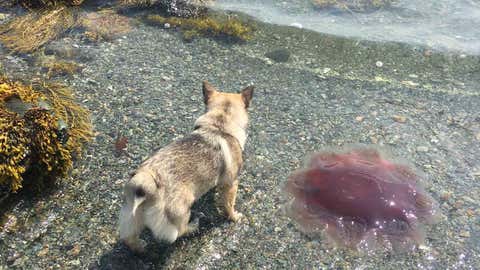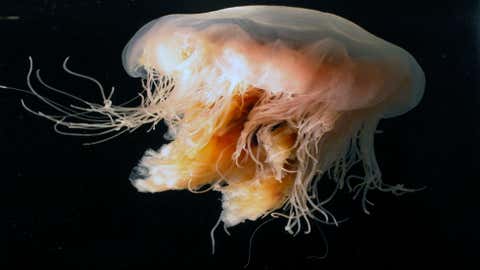
At a Glance
- The tentacles of a lion's mane jellyfish can grow up to 100 feet long.
- Beachgoers are reporting more of them this year than in the five years since tracking began.
- They are the world's largest jellyfish.
Giant jellyfish that look like oozing, bloody blobs of goo are washing ashore in Maine more frequently this year.
Officially called lion's mane jellyfish but sometimes referred to as red jellyfish, their tentacles can reach a length of 100 feet, according to the National Science Foundation. They are the largest known jellyfish on the planet.
Beachgoers are reporting more of the lion's mane jellies this year than they have since Nicholas Record, a senior research scientist at Bigelow Laboratory for Ocean Sciences in East Boothbay, Maine, started tracking jellyfish sightings in 2014. His jellyfish reporter website allows beachgoers and boaters to submit information and photos on jellyfish they've spotted.
(MORE: How Does a Home Survive Amid the Devastation of A Major Hurricane?)
The website logs a few hundred sightings each year, but usually, those reports include a wide variety of jellies.
"Some of the things that are different this year is it’s pretty much all lion's mane,” Record told weather.com in a phone interview Monday.
Not only are there more of them, but many are noticeably larger than usual.
"In a typical year, the biggest ones that people would report are typically the size of a dinner plate, and this year, I’ve gotten several reports of some that are 2 feet and a couple that are 5 feet across," Record said.
"They’re generally a sub-Arctic species and they’re not new to the Gulf of Maine by any means. But the size and just the fact that they’re all we’re seeing this year is what makes it unique."
Becky Rice-Barnes and her husband Jimmy were digging for claims at Lamoine Beach along the Gulf of Maine recently when he spotted a 5-foot red blob spread across the sand.
"My husband said, 'You're not going to believe what's over here,' and I didn't," Rice-Barnes said. "We've seen red jellyfish before, we've just never seen a red jellyfish that's huge."
Jennifer Kelly, 42, has visited her family's property near Bar Harbor at least once a year for most of her life and is familiar with lion's mane jellies. But she's never seen so many large ones at a time as she did when she was there in August. Kelly told weather.com she surveyed the 500 feet of shoreline in front of the home at nearly every low tide.
She usually saw about 10 of the jellies.
"Most of them were in the 'holy cow are you kidding me size,' like at least two feet across,” Kelly said.
"In my entire previous memory I don’t remember them being that large in that number ... There was one day where I could stand on the lawn and count 14 that I could see without actually even going on the beach.”
She sent photos of them to Record's website.

Jellyfish – and their associated stings – have become more common in many parts of the world in recent years. Some scientists think it has to do with climate change, while others point to more people on beaches as a reason for more human interaction.
Record said he doesn't know why more lion's mane jellies washed up in Maine this year, but it bears noting and tracking. He said there's myriad possibilities, from the fact that jellyfish can outcompete other sea creatures in stressed oceans, to the way they drift on ocean currents, to the presence of more docks and other structures that serve as nurseries.
The populations of jellyfish also tend to vary naturally, which can make them difficult to study.
"Jellyfish are a bit ephemeral," Record said. "There can be years with these really big blooms of jellyfish and then they might go away."
His jellyfish forecast continues to show a heightened chance of encounters with lion's mane jellyfish in the Gulf of Maine and up the coast to Halifax, Nova Scotia.
Regardless of the reason, Record said citizen reporting is a valuable tool in identifying and tracking jellyfish and other changes in areas where scientists might not have the resources to conduct an official survey.
He encourages beachgoers to submit their sightings to the online jellyfish reporter or email them to jellyfish@bigelow.org.




